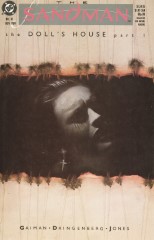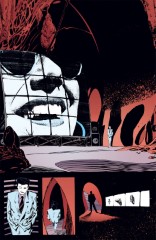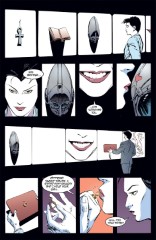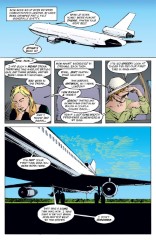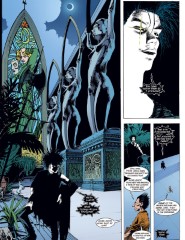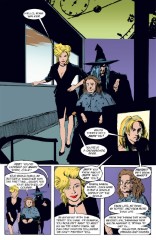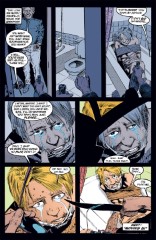Issue 10: "The Doll's House"
Neil Gaiman, Mike Dringenberg, and Malcolm Jones III
- First part of long storyline The Doll's House
- Second story reprinted in trade paperback The Doll's House
- Audible Act I Chapter 11
- Netflix Episode 7
Page 1#
We have learned in earlier issues that Desire is Dream's younger sibling. Despite the pronoun games in the fourth caption, Desire is consistently referred to by those who know it as "it". This is Desire's first known appearance. The "Doll's House" of the title refers to many buildings throughout this storyline, one of which is the Threshold.
The Audible version expands considerably on the description of The Threshold given on the page.
Page 2#
Panel 3
The Audible (and Netflix) versions both use "she/he/they" to refer to Desire, rather than "it" as used in the comic.
Page 3#
Panel 1
The figure in the lower right is Desire. The face in the "tv screens" may be the Corinthian, who shows up later. There is also some resemblance to Neil Gaiman himself, except that the editor in the letter column in issue 15 says "That was NOT a photo of Neil on page 3. As far as you know."
Page 4#
Panel 1-3
Desire is looking at the symbols of its relatives, the Endless, a group of seven anthropomorphized concepts. The symbols may be, left to right, in descending "age" of the concept. Left to right, they are: Death's ankh, Destiny's book, Dream's helmet. The empty square will acquire more meaning shortly. Then comes Desire's chin, then one we will meet immediately, and another we will meet later.
Panel 2
Desire says "Big brother, I'm watching you". This is a reference to George Orwell's 1984 ("Big brother is watching you").
Page 5#
Panel 2
First known appearance of Desire's twin sister Despair, whose sigil is a barbed ring (without immediately apparent symbolism), which was in the sixth square on page 4.
Panel 3
The missing prodigal is the Endless whose symbol is missing from the blank square. We will find out which concept this is much later.
Panel 6
Desire was manipulating Dream and/or Nada in issue 9.
Panel 7
We do not know, but will learn, what a dream vortex is.
Page 6#
First known appearances of Miranda and Rose Walker, who will be very important to this storyline, and, on the next page, Mr. Jack Holdaway, who will not. It will be confirmed later that Rose is in fact the person Judy was talking to on page 6 of issue 6.
Panel 2
This is a dream. This should absolutely leap out at you.
Panel 3
London has three airports, of which Heathrow is the largest, and Gatwick the second in importance. It is reputed to be less pleasant to fly from than Heathrow.
Page 7#
Panel 4
Masterpiece Theater is a television show on American public TV; it perhaps exclusively features British productions of, well, masterpieces of literature adapted to television.
Panel 6
"Car-park" is British; the American equivalent is both "parking lot" and "parking garage".
Page 9#
Panel 1-2
We are seeing Rose's dream; Rose is slipping directly into Dreaming, which is perhaps unusual. The dream sequence is printed sideways on the page. At least two other series, Cerebus ##44-50 and Fantastic Four #252 have used the same format.
Panel 2-3
This is the House of Secrets. The characters are Abel, Lucien, and Goldie. For more, see issue 2.
Panel 7
Lucien is taking a census. It struck me as funny that the census rolls include "Something Nasty in the Basement". I can just see the junk mail from Ed McMahon: "On January 23, will I announce 'Mr. Something N. Basement has just won $23 million dollars? Enter now!" It does not appear that Mr. Basement or the Bottle Imp date back to the original run of House of Secrets.
Page 10#
Panel 2
The first appearance of the three Guardians here, The Wyvern, the Hippogriff and the Gryphon.
Panel 4
Neil Gaiman says "Note the doll": Well isn't it the same doll's house which we find in the room of who-was-to-be-a-dream-vortex, Unity Kinkaid? Just look at the Morpheus in its window on pages 22-23.
Page 11-12#
Panel 4
This is a double page spread. "Major Arcana" originally referred to the non-suited cards in a Tarot deck. Here the term refers to the more important denizens of the Dreaming. This refers back to the introduction to Sandman #8, where we saw a high-number Tarot card with a representation of Dream on it.
Page 13#
Panel 1
Brute and Glob appeared in the 1970s run of Sandman. For more, see issue 2.
Panel 2-3
The first known appearances of the Corinthian and Fiddler's Green. Note that there is something unusual about the Corinthian's eyes. Doesn't Corinthian look like Oscar Wilde here? Well just remember about Dorian Gray, young, dandy, and blase, creature from nightmares himself, he continues beautiful, while his portrait gets older and wicker.
Caleb Carr wrote a popular novel in 1994 set in 1896 new york city, in which a criminal psychiatrist or "alienist" as they were called at the time, hunts down a serial killer with a taste for young boy whores. His signature was the cutting out of their eyes. There are some strong parallels here with the Corinthian - first, the novel is populated with real historical characters, like Theodore Roosevelt as the police commissioner - something Gaiman himself likes to do. Second, the Corinthian is a character that has skulked about through history cutting people's eyes out (see Cor's appearance in Brief Lives where he cuts out the eyes of the ape being dissected by the scientist in Victorian England).
Although 1896 is too early for the Corinthian to be out of dreams on his own, we know that he's always been a 'naughty' character. I think Gaiman plucked him out of this novel for use in Sandman. (this was contributed by Simon Cheesman)
The Corinithian could not have been taken from The Alienist, because Sandman #10 came out at least three years before the Alienist was written! The Alienist wasn't written until 1994 as you note: Sandman #10 came out in 1990/1991! Kull29@aol.com
According to the online Oxford English Dictionary 2d. ed., Fiddler's Green is "a sailor's elysium, in which wine, women, and song figure prominently." Citations date back to 1825. In one citation, tailors and musicians are cantoned (or quartered) in Fiddler's Green. Also according to the online OED, Corinthian relates to the Greek city of Corinth. It is also one of the three Grecian orders of columns, a type of brass or bronze, whence also a meaning equivalent to "brassy" or "brazen," as effrontery, an excessively elegant literary style, an amateur yachtsman, and a variety of bagatelle. Further, and probably the meaning most apt here, it refers to a wealthy or fashionable man, or one who is profligate, idle, or licentious.
Page 14#
- Annulet is defined on the next page. Rose is the dream vortex. The inference from Lucien's remarks is that most vortices are objects, but that it is not unknown for them to be human.
Page 16#
Panel 1
Unity Kinkaid was first seen in issue #1 as one of the victims of "Sleepy Sickness". Unity looked like China doll, in the "Doll's house", with the doll's house in her room, doll of destiny which made her sleep during almost 70 years, have a child, not knowing a father, being a tool in Desire's games (note that Desire is just playing, just like Corinthian on p. 24), at present in nursing home, which other of doll's houses (side by side with dreaming, Desire's palace, and Abel's house present just in this issue of the story).
Panel 4
One assumes that a genuine doll's house is at least metaphorically related to the "Doll's House" of the title.
Panel 6
Don't we have here a word game borne - born?
Page 17#
Panel 3
In the mirror we have the anticipation of the visit of three-in-one. Well, witches used to use mirrors for foreseeing the future.
Page 18#
Panel 2
Dream dressing the night, as Death would say "Doesn't it sound cute?!"
Page 19#
The Three-in-One Goddess. See issue 2.
Panel 3
There was a boy named Jed connected with the 1970s Sandman. The "Kindly Ones" are the Eumenides of Greek mythology, also known as the Erinyes, and in English as the Furies. Their names are Tisiphone, Alecto, and Megaera. They punish mortals who dare to compare themselves to gods ("hubris"). Aeschylus named the third play of a trilogy Eumenides.
Page 20#
Panel 2
Jeez, the Three are well-disposed toward Rose. The crone aspect spills the beans even though Rose didn't ask the right questions.
Panel 4
"Daughter, sister, child" is because of the mother, maiden, crone symbolism.
Page 21#
Panel 1
Broom closet, well,well well, who doesn't know that witches (and Hecate, or three-in-one is their Goddess) use broomsticks to fly?
Page 22#
Panel 5-6
Morpheus is watching the scene (dreaming it?) from the doll's house in the corner of the room, just as Rose was watching his kingdom's affairs in her dreams.
Page 23#
Panel 1
Look at the picture and see the dialogue: "Here you are!"
Panel 4,5,6
Here we have Unity symbolically transferring the powers of the vortex to Rose, using annulet (Lucien's words). So here we have a magical ring!
Page 24#
The Corinthian, we learn, is a sick bastard, and is probably about to kill Davy. We are seeing the world through Corinthian's eyes, as he takes off his dark glasses (panel 5-7) we can see colors. So I think that we are lucky that the story is ending just here!
The Audible version gives away a little more here (that the observant will have noticed anyway back on p13.)
Credits
- Originally collated and edited by Greg Morrow.
- Matt Rollefson draphsor@deathstar.Stanford.EDU suggests that the face on page 3 is the Corinthian. He and Andrew David Weiland aw1s+@andrew.cmu.edu elucidated "The Kindly Ones."
- Michael Seymour Collins mcollins@isis.cs.du.edu explained about Gatwick and car-parks.
- William Sherman sherman@oak.math.ucla.edu found the sideways issues of Cerebus.
- Matt Telles mattel@auto-trol.com failed to remember the Bottle Imp and Something Nasty in the Basement.
- kieran kieran@cmatter.physics.indiana.edu ransacked the OED for Fiddler's Green and D. W. James vnend@phoenix.Princeton.EDU did the same for Corinthian.
- Ian Taylor ian@airs.com identified the Fantastic Four issue.
- Tanaqui C. Weaver cen@vax.oxford.ac.uk commented and forwarded some Neil Gaiman comments on various Endless-related stuff, the Major Arcana, and the doll on page 10.
- Piotr Kilanowski peterpan@abordo.com.br.
- Simon Cheesman.
- Ralf Hildebrandt added more details.
Last modified by Richard Munn on 2023-08-17 - Fixed formatting
[edit this page] [page history]
